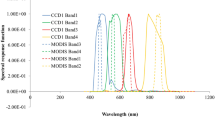Abstract
Based on the conduction and transformation of the thermal infrared radiative transfer equation of water target, a twin-channel difference model (DM) was proposed to improve the calibration precision by conquering the limitation that the atmospheric condition when image is acquiring cannot be truly obtained in the traditional radiometric simulation calibration method. The analysis of surface, atmosphere and top-of-atmosphere (TOA) radiative energy decomposition demonstrated that the apparent TOA radiance of the uncalibrated channel is the differential combination of two reference channels. The DM avoids impacts from atmospheric temperature and density. The only impact is from water vapor (WV) content. Based on the fitting error analysis of 742 mid-latitude atmospheric profiles (column WV content: 0–5×103 atm cm) selected from TIGR database, the DM is insensitive to WV content. The maximum error is less than 0.2 K when the view zenith angels (VZAs) of reference channels and uncalibrated channel are less than 30°. The error becomes 0.3 K when VZAs range from 30° to 40° and 0.6 K when VZAs are in 40°–50°. Because the uncertainty increases when VZAs are larger than 50°, the best range of VZAs is 30°–50°. The vicarious calibration results at Lake Qinghai field indicated that the calibration precision of the DM cross-calibration by using MODIS bands 31 and 32 as reference channels to calibrate IRS band 08 is similar to that of vicarious calibration. Therefore, the DM is a reliable alternative tool for sensor on-orbit calibration and validation with high precision and frequency.
Similar content being viewed by others
References
Merchant C J, Simpson J J, Harris A R. A cross-calibration of GMS-5 thermal channels against ATSR-2. Remote Sensing Env, 2003, 84: 268–28
Jiang G M, Yan H, Ma L L. Intercalibration of SVISSR/FY-2C infrared channels against MODIS/Terra and AIRS/Aqua channels. IEEE Trans Geosci Remote Sensing, 2009, 47: 1548–1558
Teillet P M, Barker J L, Markham B L, et al. Radiometric cross-calibration of the Landsat-7 ETM+ and Landsat-5 TM sensors based on tandem data sets. Remote Sensing Env, 2001, 78: 39–54
Heidinger A K, Cao C, Sullivan J T. Using Moderate Resolution Imaging Spectrometer (MODIS) to calibrate advanced very high resolution radiometer reflectance channels. J Geophys Res, 2002, 107(D23): 4702
Doelling D R, Nguyen L, Minnis P. Calibration comparisons between SEVIRI, MODIS, and GOES data. In: Proceeding 2004 EUMETSAT Meteorological Satellite Conference, Prague, Czech Republic, 2004
Asem A, Deschamps P Y, Ho D. Calibration of METEOSAT infrared radiometer using split-window channels of NOAA AVHRR. J Atmos Oceanic Tech, 1987, 4(4): 553–562
Liu J J, Li Z. A new method for cross-calibration of two satellite sensors. Int J Remote Sensing, 2004, 25(23): 5267–5281
Vermote E F, Saleous N Z. Calibration of NOAA16 AVHRR over a dersert site using MODIS data. Remote Sensing Env, 2006, 105: 214–220
Xie Y, Wu A S, Xiong X X. Tracking long-term stability of Aqua MODIS and AIRS at different scan angles. In: Proceedings of SPIE, 2010, 7807: 780718
Gunshor M M, Schmit T J, Menzel W P. Intercalibration of the infrared window and water vapor channels on operational geostationary environmental satellites using a single polar-orbiting satellite. J Atmos Ocean Technol, 2004, 21(1): 61–68
Gunshor M M, Schmit T J, Menzel W P, et al. Intercalibration geostationary imagers via polar orbiting high spectral resolution data. SPIE Int Soc Opt Eng Atmos Environ Remote Sens Data Process. Utilization III: Readiness GEOSS, San Diego, CA, 2007, 6684: 27–28
Liou K N. An Introduction to Atmospheric Radiation. 2nd Ed. USA: Elsevier Science, 2002. 30
Schott J R, Barsi J A, Nordgren B L, et al. Calibration of Landsat thermal data and application to water resource studies. Remote Sensing Env, 2001, 78: 108–117
Chen G M, Gao X, Zhuang S Z, et al. Development of an automatic calibration device for high-accuracy low temperature thermometers. Sci China Tech Sci, 2010, 53: 8–12
Thome K, Arai K, Hook S, et al. ASTER preflight and inflight calibration and the validation of level 2 products. IEEE Trans Geosci Remote Sensing, 1998, 36(4): 1161–1171
Wan Z M, Zhang Y L, Li Z L, et al. Preliminary estimate of calibration of the moderate resolution imaging spectroradioeter thermal infrared data using Lake Titicaca. Remote Sensing Env, 2002, 80: 497–515
Wan Z, Zhang Y L, Ma X L, et al. Vicarious calibration of the moderate-resolution imaging spectroradiometer airborne simulator thermal-infrared channels. App Opt, 1999, 38(30): 6294–6306
Author information
Authors and Affiliations
Corresponding author
Rights and permissions
About this article
Cite this article
Li, J., Gu, X., Yu, T. et al. A twin-channel difference model for cross-calibration of thermal infrared band. Sci. China Technol. Sci. 55, 2048–2056 (2012). https://doi.org/10.1007/s11431-012-4819-4
Received:
Accepted:
Published:
Issue Date:
DOI: https://doi.org/10.1007/s11431-012-4819-4




